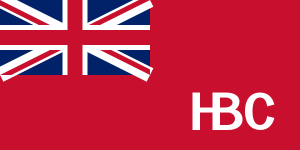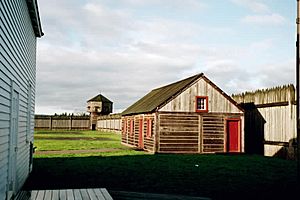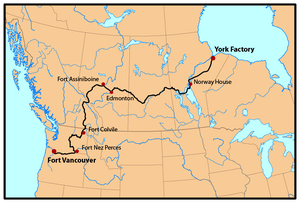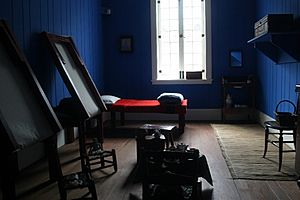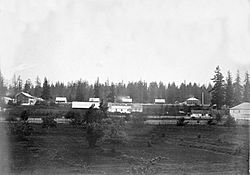Fort Vancouver facts for kids
Quick facts for kids |
|
|
Fort Vancouver National Historic Site
|
|

Fort Vancouver in 1845
|
|
| Lua error in Module:Location_map at line 420: attempt to index field 'wikibase' (a nil value). | |
| Location | Vancouver, Washington, United States |
|---|---|
| Built | 1824 |
| NRHP reference No. | 66000370 |
| Added to NRHP | October 15, 1966 |
Fort Vancouver was a 19th-century fur trading post that was the headquarters of the Hudson's Bay Company's Columbia Department, located in the Pacific Northwest. Named for Captain George Vancouver, the fort was located on the northern bank of the Columbia River in present-day Vancouver, Washington. The fort was a major center of the regional fur trading. Every year trade goods and supplies from London arrived either via ships sailing to the Pacific Ocean or overland from Hudson Bay via the York Factory Express. Supplies and trade goods were exchanged with a plethora of Indigenous cultures for fur pelts. Furs from Fort Vancouver were often shipped to the Chinese port of Guangzhou where they were traded for Chinese manufactured goods for sale in the United Kingdom. At its pinnacle, Fort Vancouver watched over 34 outposts, 24 ports, six ships, and 600 employees. Today, a full-scale replica of the fort, with internal buildings, has been constructed and is open to the public as Fort Vancouver National Historic Site.
Contents
Background
During the War of 1812, the Pacific Northwest was a distant region of the conflict. Two rival fur trading outfits, the Canadian North West Company (NWC) and the American Pacific Fur Company (PFC), had until then both operated in the region peaceably. Funded largely by John Jacob Astor, the PFC operated without many opportunities for military defense by the United States Navy. News of the war and of a coming British warship put the American company into a difficult position. In October 1813, management met at Fort Astoria and agreed to liquidate its assets to the NWC. The HMS Racoon arrived the following month and in honor of George III of the United Kingdom, Fort Astoria was renamed to Fort George.
In negotiations with American Albert Gallatin through out 1818, British plenipotentiary Frederick John Robinson was offered a proposition for a partition that would have, as Gallatin stated, "all the waters emptying in the sound called the Gulf of Georgia." Frederick Merk has argued the definition used by the negotiators of the Gulf of Georgia included the entirety of the Puget Sound, in addition to the Straits of Georgia and Juan de Fuca. This would have given the United Kingdom the most favorable location for ports north of Alta California and south of Russian America. Robinson didn't agree to the proposal and subsequent talks didn't focus on establishing a permanent border west of the Rocky Mountains.
The Treaty of 1818 made the resources of the vast region were to be "free and open" to citizens from either nation. The treaty wasn't made to combine American and British interests against other colonial powers in the region. Rather, the document states that the joint occupancy of the Pacific Northwest was intended to "prevent disputes" between the two nations from arising. In the ensuing years, the North West Company would continue to expand its operations in the Pacific Northwest. Skirmishes with its major competitor, the Hudson's Bay Company (HBC), had already flared into the Pemmican War. The end of the conflict in 1821 saw the NWC mandated by the British Government to merge into the HBC.
Later negotiations
Throughout 1825 and 1826, British officials would continue to offer Americans partition plans for the Pacific Coast of North America. These largely originated in part from correspondence with the NWC and later HBC. The border would continue to extend west on the 49th parallel to the Rocky Mountains, where the Columbia (and some times the Snake River) would be used as the border until it reached the Pacific Ocean. Secretary of State for Foreign Affairs George Canning has been appraised by later historians most supportive British Foreign minister in securing a border along the Columbia. United States Secretary of State Henry Clay had given instructions the American plenipotentiaries to offer a partition of the Pacific Northwest along the 49th parallel to the Pacific Ocean. The difference in the two considered plans were too much to solve, making the diplomats put off a formal colonial division once more.
Establishment
In the early 1820s a general reorganization of all NWC properties, now entirely under HBC management, was overseen directly by Sir George Simpson. The newly established Columbia District needed a more suitable headquarters than Fort George at the mouth of the Columbia. Simpson was instrumental in the establishment of Fort Vancouver. Using the HBC position that any settlement of the Oregon boundary dispute would place the border placed along the Columbia; Simpson selected a location situated opposite from the mouth of the Willamette River. This expanse was an open and fertile prairie that was outside the flood plain and had easy access to the Columbia.
Fort
Description
An employee of the HBC, wrote a general description of Fort Vancouver and its structural composition as its was in 1843:
"The fort is in the shape of a parallelogram, about 250 yards long, by 150 broad; enclose by a sort of wooden wall, made of pickets, or large beams firmly fixed in the ground, and closely fitted together, twenty feet high, and strong secured on the inside by buttressess. At each angle there is a bastion, mounting two twelve pounders, and in the centre there some eighteen pounders; ... these cannon have become useless. The area within is divided into two courts, around which are arranged about forty neat, strong wooden buildings, one story high, designed for various purposes..."
The fort was substantial. The palisades that protected it were 750 feet (230 m) long, 450 feet (140 m) wide and about 20 feet (6.1 m) high. Inside there were 40 buildings, including housing, warehouses, a school, a library, a pharmacy, a chapel, a blacksmith, plus a large manufacturing facility. The Governor's residence was in the center of Fort Vancouver was two stories tall. Inside was a dining hall where company clerks, traders, physicians and priest would dine with the supervising Chief Factor. In general the entire Governor's building and its meals were typically barred for general laborers and traders. After dinner the majority of these men would relocate to the "Bachelor's Hall" to "amuse themselves as they please, either in smoking, reading, or telling and listening to stories of their own and others' curious adventures." As Dunn recalled;
"The smoking room ... presents the appearance of an armoury and a museum. All sorts of weapons, and dresses, and curiosities of civilised and savage life, and of the various implements for the prosecution of the [fur] trade, may be seen there."
Outside the ramparts there was additional housing, as well as fields, gardens, fruit orchards, a shipyard, a distillery, a tannery, a sawmill, and a dairy. By 1843, situated roughly 600 yards outside Fort Vancouver were about about sixty wooden houses. This small settlement was inhabited by fur trappers, machinists and other laborers of the fort. There they resided with their Indigenous or Métis wives and families. The dwellings were organized into orderly rows. The settlement was commonly refereed to as Kanaka Village because of the many Hawaiians in company employ who lived there. In fact, it's been suggested that the Fort had the "largest single group of Hawaiians ever to congregate outside their home islands."
Personnel
For most of its existence, Fort Vancouver was the largest non-indigenous settlement in the Pacific Northwest. The populace of the fort and the surrounding mostly French-Canadians, Métis and Kanaka Hawaiians; there were also English, Scots, Irish, and a variety of Indigenous peoples including Iroquois and Cree. The common language spoken at the fort was Canadian French, while company records and official journals were kept in English. However, trading and relations with the surrounding community were done in Chinook Jargon, a pidgin of Chinook, Nootka, Chehalis, English, French, Hawaiian and other elements.
A survey of the total personnel at Fort Vancouver in 1846 reveals a culturally and materially diverse populous. Notably, the number of employees from the Hebrides, the Orkney and Shetland Islands was 57 men. This is the exact same amount as the combined number of workers from England and mainland Scotland. The amount of men hired from Upper Canada, Lower Canada and Rupert's Land was in total 91. These men came from English, French-Canadian, Métis, Iroquois, Cree and other cultural backgrounds. Most notable however, was that Kanaka Hawaiians totaled 154 that year, or 43% of the total fort population.
Chief Factor Dr. John McLoughlin was its first manager, a position he held for nearly 22 years, from 1824 to 1845. McLoughlin applied the laws of Upper Canada to British subjects, kept peace with the natives and sought to maintain law and order with American settlers as well. McLoughlin was later hailed as the Father of Oregon. Against the Company's wishes, he provided substantial aid and assistance to westbound Americans settlers in the territory. He left the company in 1846 to found Oregon City in the Willamette Valley.
James Douglas spent nineteen years in Fort Vancouver; serving as a clerk until 1834 when he was promoted to the rank of Chief Trader. From October 1838 to November 1839, while McLoughlin was on furlough in Europe, Chief Trader Douglas was in charge. In November 1839 Douglas was promoted to the rank of Chief Factor. Douglas took on several temporary assignments elsewhere, to set up HBC's trading post at Yerba Buena (San Francisco) California in 1841, and to establish Fort Victoria in 1843, but from 1839 to 1845 there were normally two Chief Factors based at Fort Vancouver, with McLoughlin in charge and Douglas as his subordinate.
Agricultural production
At its inception Simpson wanted the fort to be self-sufficient as food was costly to ship. Fort staff typically maintained one year's extra supplies to avoid the disastrous consequences of ship wrecks and other calamities. Fort Vancouver began to produce a surplus of food, some of which was used to provision other HBC posts. The area around the fort was commonly known as "La Jolie Prairie" (the pretty prairie) or "Belle Vue Point" (beautiful vista). In time Fort Vancouver would diversify its economic activities and begin exporting agricultural foodstuffs from HBC farms, along with salmon, lumber, and other products. It developed markets for these exports in Russian America, the Kingdom of Hawaii, and Mexican California. The HBC opened agencies in Sitka, Honolulu, and Yerba Buena (San Francisco) to facilitate such trade.
Express
Fort Vancouver was supplied in part through the overland York Factory Express. It originated from a route used by the NWC between Fort George to Fort William on Lake Superior. Each spring two brigades were sent, one from Fort Vancouver and the other from York Factory. A typical brigade consisted of about forty to seventy five men. These men carried supplies, furs and correspondence by boat, horseback and in backpacks for various HBC posts and personnel along the route. Furs stored at the York Factory would in turn be sold at London in an annual fur sale. Indians along the way were often paid in trade goods to help them portage around falls and unnavigable rapids.
Americans
The Hudson's Bay Company, which controlled the fur trade in much of what Americans styled the Oregon Country, had previously discouraged settlement because it interfered with the lucrative fur trade. By 1838, however, American settlers were coming across the Rocky Mountains and their numbers increased each subsequent year. Many left from St. Louis, Missouri and followed a fairly straight, but difficult, route called the Oregon Trail. For many settlers the fort became the last stop on the Oregon Trail where they could get supplies before starting their homestead.
During the Great Migration of 1843 an estimated 700 to 1,000 American settlers arrived via the Oregon Trail.
Oregon Treaty
Signed in 1846, the Oregon Treaty set the Canada–United States border at the 49th parallel north, putting Fort Vancouver within American territory. Although the treaty ensured that the HBC could continue to operate and had free access to navigate the Strait of Juan de Fuca, Puget Sound, and the Columbia River, company operations were effectively stifled by the treaty and became unprofitable and were soon closed down.
Restoration
Because of its significance in United States history a plan was put together to preserve the location. Fort Vancouver was declared a U.S. National Monument on June 19, 1948, and redesignated as Fort Vancouver National Historic Site on June 30, 1961. This was taken a step further in 1996 when a 366-acre (1.48 km2) area around the fort, including Kanaka Village, the Columbia Barracks and the bank of the river, was established as the Vancouver National Historic Reserve maintained by the National Park Service. It is possible to tour the fort. Notable buildings of the restored Fort Vancouver include a bake house, where Hardtack baking techniques are shown, a Blacksmith shop, a carpenter shop and its collection of carpentry tools, and the kitchen, where daily meals were prepared.


